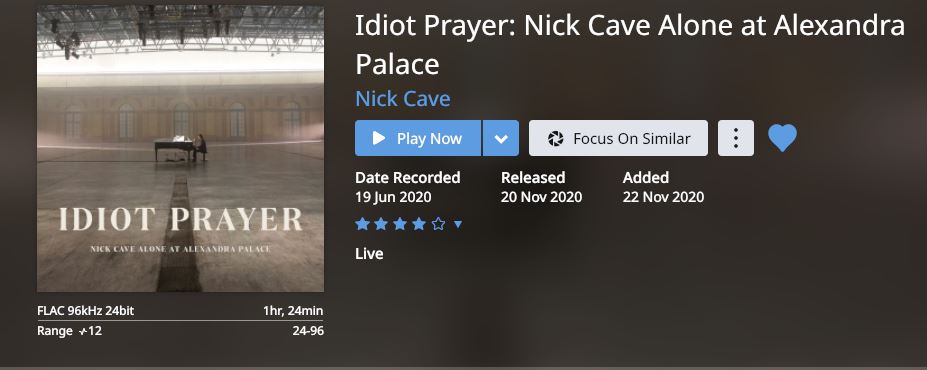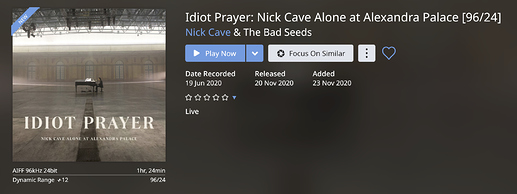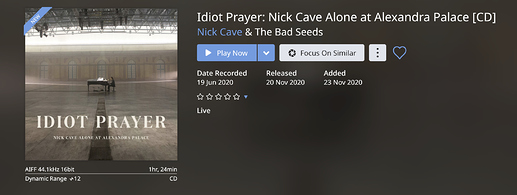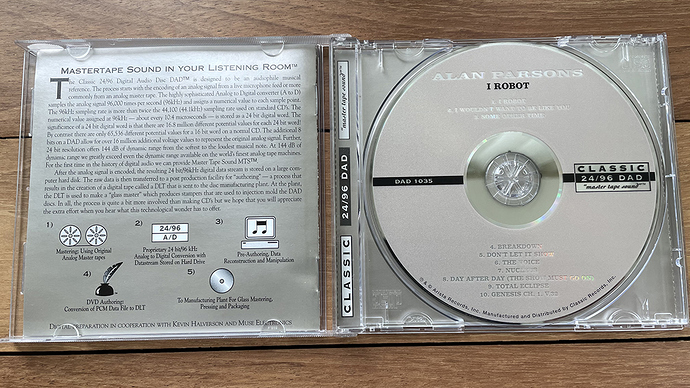A friend bought the hi res download for me from Qobuz.
Thanks. I have a thought, that perhaps I will acquire the downloads through Sublime, and do a little headphone critical listening. Haven’t seen the album on HDTracks or ProStudioMasters though.
UPDATE: I purchased the HiRes [96/24] and CD quality files from Qobuz. I have downloaded them and installed them in my Roon library. According to Roon, both albums have the same dynamic range, which is what I expected. This doesn’t mean the hires file doesn’t sound better than the Redbook, but DR is probably not the reason. As I wrote above, I am still hoping to find out how the album was recorded.
P.S. BTW, that symbol they use for the dynamic range indicator is not a ± sign; it’s a little frequency response/dynamic range icon.
Starting a three-way comparison between the HDAD, DSD download, and MoFi SACD.
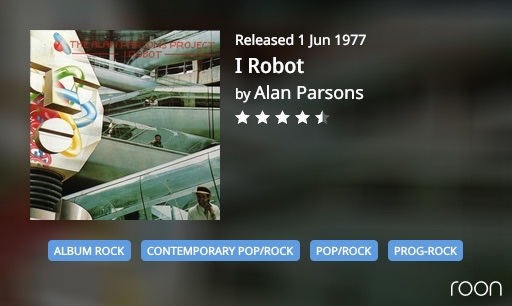
My ears are better than my eyes ![]()
If I’m not mistaken, Alan Parsons released the original PCM master into HDAD (PCM) - I think I’ve got that disc laying somewhere (in DVD disc format, which unfortunately my Vivaldi Transport can’t read). The SACD/DSD releases must be derivatives? ![]()
Anup, I think that’s right. The HDAD is quite good. It I’ve not heard the MoFi SACD before. And I don’t know its actual provenance.
You and me both. I had to zoom in to be sure. ![]()
Yes but of what? The album was recorded in 1976 to 1977 and , despite what it says on the SPARS code on the CD, I am pretty sure that with those dates it was made using analogue multi-track at Abbey Road. The first digital rock album was Bop Till You Drop/Ry Cooder 2 years later in 1979.
So any PCM version was not “original” in the usual use of the word but a later digitisation of the analogue 2 track production master. The SPARS code on the original CD of DDD must have stretched the truth by counting that digitisation as part of the process of the original recording - record labels dissembling? Surely not ![]()
The point is that there is no obvious way therefore , outside of a production statement, of knowing any subsequent digital releases’ provenance. Are they fresh digitisations of the analogue 2 track using higher resolutions or are they transcodings and/or upsamples of the PCM 2 track made for the CD release? I am afraid that the existence of earlier releases provide no clues.
Who knew? ![]() Anyway, sometimes MoFi supplies good detail about their production process. We shall see.
Anyway, sometimes MoFi supplies good detail about their production process. We shall see.
Well I think that it is pretty well documented that Abbey Road first used digital recording in 1979 and I Robot was certainly recorded there 2 -3 years earlier, it being the location of Alan Parson’s day job ( recording engineer).
No argument about that at all. But MoFi often identifies their source tapes/files, etc., and explains exactly what they’ve done with them.
Sorry Greg, I wasn’t quite with you but now I understand. Yes, I look forward to learning of MoFi’s comments on the provenance of their SACD. My friend who recently retired from one of the major record companies always calls them “SAD CDs”. He has nothing against them but he misread the designation when they were launched and it stuck. OK, he’s got me doing it now 
No worries Pete. Some of them really are just SAD CDs, another wallet-scooping ploy by the labels. Thankfully, not all of them. 
Good point as usual Pete ![]() . I just assumed the SACD would be from a PCM master instead of the original analog masters (which no doubt Arista has under tight lock & key).
. I just assumed the SACD would be from a PCM master instead of the original analog masters (which no doubt Arista has under tight lock & key).
I was curious so I searched for my old Classic Records HDAD disc (it’s probably been over a dozen years since I’ve touched that disc!). Unfortunately it doesn’t contain any technical details of the transfer.
MOFI also unfortunately doesn’t seem to get into the (technical) details of their 2016 SACD , but I have to say, their description makes it very tempting to pick one up.
I should probably just wait for Greg’s review first ![]()
Yeah, I also went looking for the original HDAD disc, but couldn’t find it in the discs I still keep in the library for playback. So, I will have to look for it over the weekend in storage. That MoFi disc description sure has some great marketing fluff. Waxing lyrical so to speak. But not much in the way of detail. We will see.
Ahead of his time and mandatory platter time for the “sophisticated single graduate student.” 
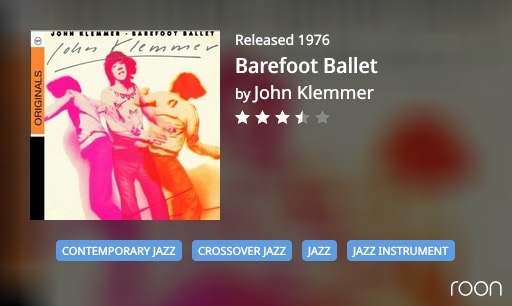
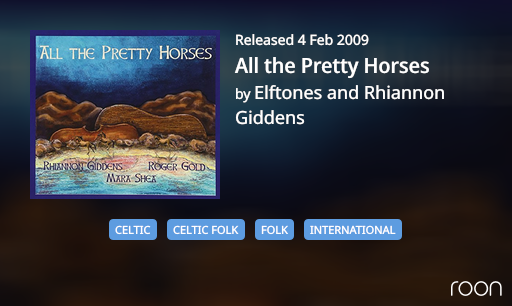
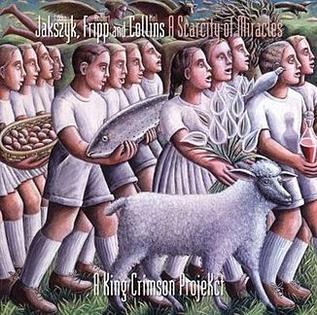
A Scarcity of Miracles is the lone album by Jakko Jakszyk, Robert Fripp and Mel Collins, released in 2011. It united singer and guitarist Jakko Jakszyk with three musicians best known from King Crimson, guitarist Robert Fripp, saxophonist Mel Collins and bassist/Chapman Stick player Tony Levin. Porcupine Tree member Gavin Harrison was featured on drums. Jakszyk and Harrison would go on to participate together in the next incarnation of King Crimson.
Presented as “a King Crimson ProjeKct” (or spin-off), the album started as a series of improvisations between Jakszyk and Fripp, with Collins adding his parts later. Levin and Harrison joined in near the end of the process, once Jakszyk had shaped the material into songs with fully formed melodies and lyrics.
I listen to the 24/96 version from the CD/ DVD release, recorded in MLP, Meridian Lossless Packing:
Just a small point; MLP isn’t a recording format so you can’t record “in” it. It is a way of packing the data (recorded in e.g. 24/96 PCM as in your example) for the sound on an optical disc, specifically DVD. As I understand it is broadly similar conceptually ( but different to) the lossless packing that I believe dCS developed for packing DSD data on SACD. Or, for that matter, as FLAC losslessly packs PCM data. It’s a kind of digital audio zip file.
BTW, if you are interested in King Crimson and related music I highly recommend Bill Bruford: The Autobiography. To avoid confusion, it’s a book.
Thanks Pete, I should have written recorded with MLP.
This album sounds terrific.
I think I have about everything recorded by King Crimson 
[Edit] : from the DVD inlay: not recorded with / in MPL, but mixed in MLP:
DVD Audio Content:
Album mixed in:
MLP lossless 5.1 surround
DTS 5.1 digital surround
Stereo album mix and alternate mixes:
MLP lossless stereo (24/96)
PCM stereo 2.0 (24/48)
Why it is in the mixing:
https://www.meridian-audio.info/public/mlp_jap_new[2521].pdf
